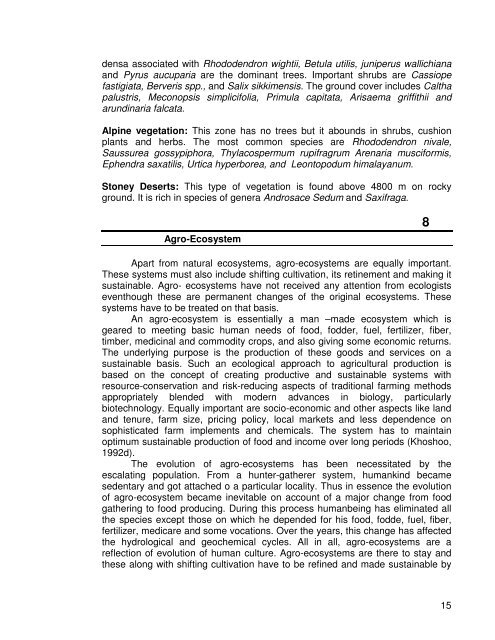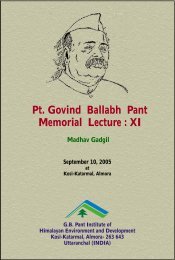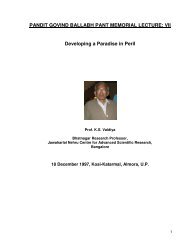Pandit Govind Ballabh Pant Memorial Lecture: II
Pandit Govind Ballabh Pant Memorial Lecture: II
Pandit Govind Ballabh Pant Memorial Lecture: II
Create successful ePaper yourself
Turn your PDF publications into a flip-book with our unique Google optimized e-Paper software.
densa associated with Rhododendron wightii, Betula utilis, juniperus wallichiana<br />
and Pyrus aucuparia are the dominant trees. Important shrubs are Cassiope<br />
fastigiata, Berveris spp., and Salix sikkimensis. The ground cover includes Caltha<br />
palustris, Meconopsis simplicifolia, Primula capitata, Arisaema griffithii and<br />
arundinaria falcata.<br />
Alpine vegetation: This zone has no trees but it abounds in shrubs, cushion<br />
plants and herbs. The most common species are Rhododendron nivale,<br />
Saussurea gossypiphora, Thylacospermum rupifragrum Arenaria musciformis,<br />
Ephendra saxatilis, Urtica hyperborea, and Leontopodum himalayanum.<br />
Stoney Deserts: This type of vegetation is found above 4800 m on rocky<br />
ground. It is rich in species of genera Androsace Sedum and Saxifraga.<br />
Agro-Ecosystem<br />
8<br />
Apart from natural ecosystems, agro-ecosystems are equally important.<br />
These systems must also include shifting cultivation, its retinement and making it<br />
sustainable. Agro- ecosystems have not received any attention from ecologists<br />
eventhough these are permanent changes of the original ecosystems. These<br />
systems have to be treated on that basis.<br />
An agro-ecosystem is essentially a man –made ecosystem which is<br />
geared to meeting basic human needs of food, fodder, fuel, fertilizer, fiber,<br />
timber, medicinal and commodity crops, and also giving some economic returns.<br />
The underlying purpose is the production of these goods and services on a<br />
sustainable basis. Such an ecological approach to agricultural production is<br />
based on the concept of creating productive and sustainable systems with<br />
resource-conservation and risk-reducing aspects of traditional farming methods<br />
appropriately blended with modern advances in biology, particularly<br />
biotechnology. Equally important are socio-economic and other aspects like land<br />
and tenure, farm size, pricing policy, local markets and less dependence on<br />
sophisticated farm implements and chemicals. The system has to maintain<br />
optimum sustainable production of food and income over long periods (Khoshoo,<br />
1992d).<br />
The evolution of agro-ecosystems has been necessitated by the<br />
escalating population. From a hunter-gatherer system, humankind became<br />
sedentary and got attached o a particular locality. Thus in essence the evolution<br />
of agro-ecosystem became inevitable on account of a major change from food<br />
gathering to food producing. During this process humanbeing has eliminated all<br />
the species except those on which he depended for his food, fodde, fuel, fiber,<br />
fertilizer, medicare and some vocations. Over the years, this change has affected<br />
the hydrological and geochemical cycles. All in all, agro-ecosystems are a<br />
reflection of evolution of human culture. Agro-ecosystems are there to stay and<br />
these along with shifting cultivation have to be refined and made sustainable by<br />
15











